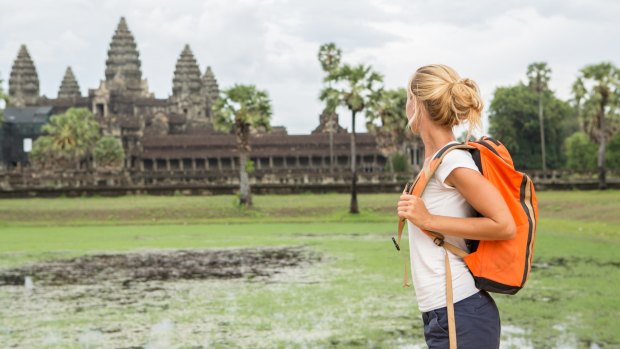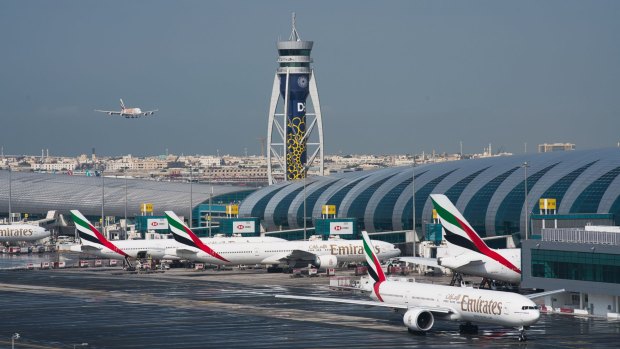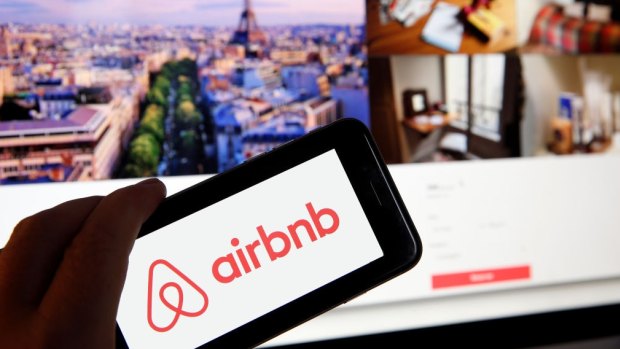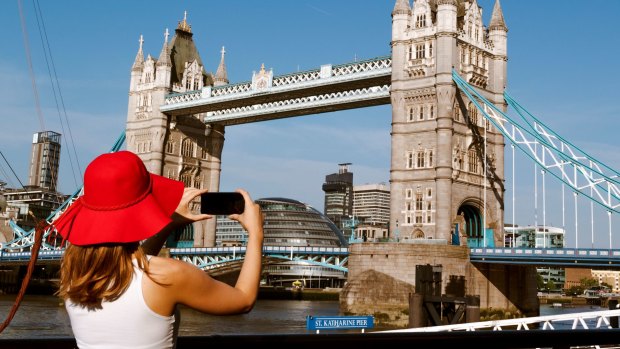This was published 3 years ago
Travel and COVID-19: The golden age of cheap, easy travel is over

In the year 2000, you could have had Cambodia's famous Angkor Wat temple virtually to yourself.Credit: iStock
We've just lived through a golden age of travel. Until COVID-19 came along and kneecapped our plans, the travel gods smiled on us.
Over the past two decades, travel has become cheaper, new airlines have opened up fresh routes with easy access to new destinations, the sharing economy has brought us couchsurfing and Airbnb and technology has transformed the way we travel.
Here are some reminders of how travel looked in the year 2000, compared with pre-pandemic 2019.
Choice of airlines

Credit: AP
Back in 2000 you could fly from Australia to Vienna with Lauda Air. Or to Paris with OAM French Airlines, to Italy with Alitalia, Amsterdam with KLM or Athens with Olympic. In 2019 the only European carrier still flying into Australia was British Airways.
Over that same period services from Middle East carriers Emirates, Etihad and Qatar ramped up to make the Gulf States a powerhouse air travel hub for Australians heading for Europe. Those airlines now offer one-stop flights between Australia and all the capitals once served by the European carriers, and many more cities in Europe and Africa besides.
Meanwhile, the number of China-based airlines flying into Australia went from zero to seven between 2000 and 2019, offering non-stop flights to 20 cities across China with onward connections to other parts of Asia and Europe.
Competition among these airlines is the reason that we were able to enjoy cheap international air travel right up until the start of 2020. The price of a return ticket from Australia to Europe has actually declined this century. In Europe's summer of 2019 you could fly return to Europe for as little as $1500 if you booked far enough in advance, about $350 less than the same journey would have cost in 2000.
By 2019 cities such as Adelaide and Brisbane were served by more frequent international services to a greater range of cities than in 2000. Even Canberra had international services aboard Singapore Airlines and Qatar Airways.
Where we went
Cambodia was inching toward normalcy in 2000, and you could still have a sunset view of Angkor Wat without the hordes that now infest it. One of the last of the unrepentant communist dinosaurs, Cuba had just thrown open the front door to lure foreign tourists with the world's finest cigars, locals who dance salsa all night, bars haunted by Hemingway's ghost and traffic that consisted largely of Detroit chrome-mobiles from the 1950s.
A handful of ice-strengthened cruise vessels were beginning to take mere mortals to experience the wonders of Antarctica. These were small expeditionary ships that evoked memories of Shackleton and Scott, and a far cry from the current fleet of ice explorers, some of which come with spas and glass-walled underwater cocktail lounges.
Oman, one of the most traditional-minded of the Arab states, had only recently emerged from a long period of isolation, offering a postcard procession of forts, date-palm oases, desert mountains, bazaars, frankincense trees and a male population who regard a dagger in the waistband as an essential item of daily attire.
By 2019 travel had become easier in all those countries. The appeal of cold and spectacular places put Iceland and the Faroe Islands on the wish-list, we went mad for Morocco and India but Syria, one of the jewels of the Arab world, was now out of bounds.
Where we stayed

Credit: Getty Images
In 2000 you stayed in a hotel, a resort, maybe a guesthouse or a B&B – and then in 2007 a couple of roomates in San Francisco were struggling to pay their rent so they turned their loft into a cool space, complete with a blow-up sleeping mat and breakfast, advertised it on the internet - and Airbnb was born.
It's been one of the great disrupters of world travel, turning the accommodation industry on its head and allowing us to experience local life and pay less per night. By the end of 2019 over 100,000 cities had Airbnb listings, 2 million guests were staying in an Airbnb somewhere in the world on any given night and in that year Airbnb notched up close to 200 million room nights.
Another win for travellers, Uber, Ola, Lyft and other ride-share services brought us cheaper journeys, undermining the world's taxi industry.
DIY travel bookings
The era of the online travel agency was only just dawning in 2000. Websites such as lastminute.com, Travelocity and Farechase existed but they had little momentum.
TripAdvisor, which quickly became the go-to site for anyone wanting to check independent hotel reviews, was only just hatched that year. Expedia was in its infancy, a division of Microsoft, finding its way in the brave new world of e-travel, and funding some bold experiments in the travelsphere.
There were no travel aggregators of the likes of Skyscanner or Momondo that allowed you to compare air ticket prices. If you wanted to book an airline ticket, a hotel, a cruise or a package holiday you either did it yourself over the phone or went to a real, physical travel agency and sat down with a human.
By 2019 you could research your trip and build your own itinerary down to the last detail without leaving your desk, or even your couch.
Mobile phones spread their wings

Credit: iStock
The must-have mobile phone in 2000 was the Nokia 3310. A wonder of its day, it came with a calculator, a stopwatch, four games, 35 ringtones and a Chat function that allowed it to send super long SMS text messages of 459 characters – wow! The Global System for Mobile Communications (GSM) was around back then – in 1993 Telstra was the first non-European operator to sign the GSM MoU 32 networks on air in 18 countries – so you could make calls from overseas using your mobile phone, but smartphones with touchscreens and the apps that enliven our lives were still years away.
Compare those dark days with the pocket wizards of 2019 that help us navigate the souks of Marrakech, communicate with taxi drivers in Moscow, make free video calls, listen to our favourite music, check the weather forecast, move funds around and send hilarious TikTok videos to the folks back home.
Our dollar
Over the course of 2000 it would have cost you anything from $1.78 to $1.51 to buy just one US dollar. In 2019 that same US dollar was priced at around $1.49 Aussie dollars. In 2000 one Aussie dollar bought around 62 Japanese yen but in 2019 that dollar bought you about 12 yen more.
Better still is the rise in our dollar against the British pound. In 2000 a trip to the UK required a deep dive into our pockets with just one British pound costing anything from $2.45 to $2.80. In 2019 that pound would cost about $1.80.
In 2000 the EU was still a couple of years away from issuing euro notes and coins, so you were still paying in French francs or Italian lire, and your coffee in Modena – a short black, naturally, taken standing up at a local bar - would have cost you 1000 lira, about 85 cents. In 2019 that short black, at one euro, had almost doubled to about $1.65.
Will the golden age return?
Where to from here? Has COVID-19 changed the way we travel forever, or are we just in pause mode? There's a big question mark hanging over the future of travel, but there are airlines with thousands of expensive aircraft sitting idle, hotels with empty rooms, ships tied up and millions of drivers, chefs, waiters, guides, gondoliers and a hundred more occupations who depend on tourism for their living. And the urge to experience the world in all its rich flavours is sharp as ever.
My bet: as soon as it's safe to travel again we'll be packing our bags.
See also: The countries open to Australian tourists (but we're not allowed to go)
See also: The new terms travellers need to know in the COVID-19 era
Sign up for the Traveller newsletter
The latest travel news, tips and inspiration delivered to your inbox. Sign up now.